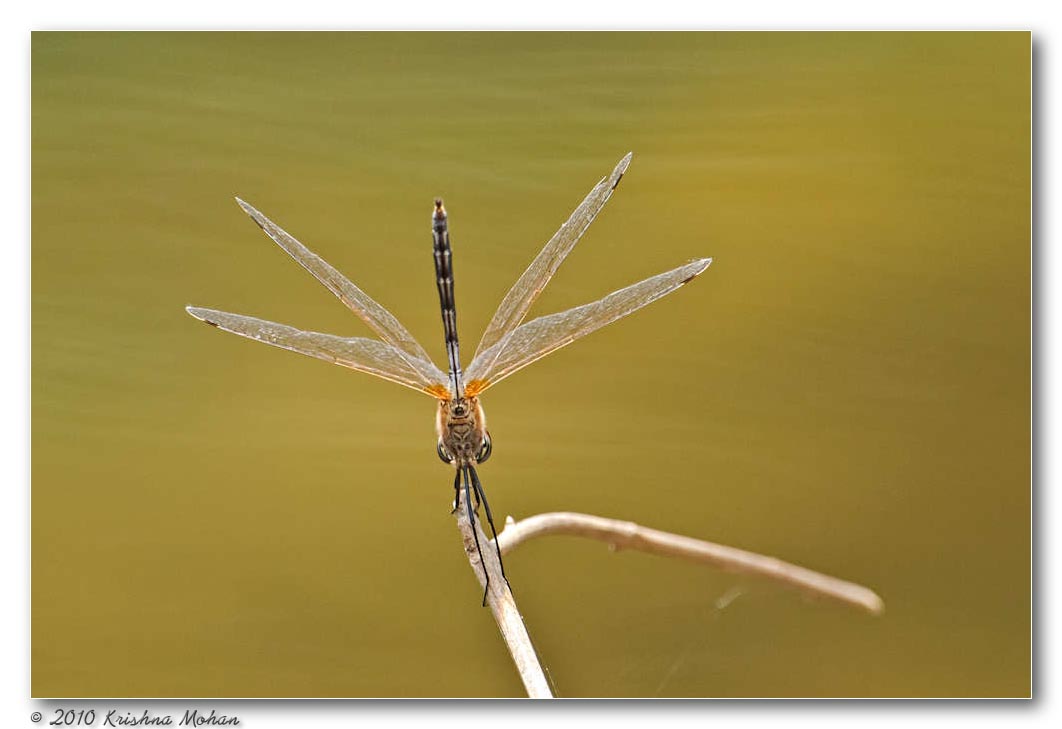Trying to go beyond my comfort zone has been my effort for last few months. I tried my hands in travel photography in my Lakshadweep island trip. Now I am trying my hands with my new lens Canon EF 300mm f/2.8 L IS USM. I bought this lens as I wanted a considerable reach for shooting birds. After trying out Canon EF 300mm f/4.0 L IS USM lens successfully for macro it was difficult to use Canon EF 300mm f/2.8 L IS USM. There were 2 main reasons. Minimum focusing distance of 300mm f/4 was 1.5meters with a magnification of 0.24x. With 300mm f/2.8 minimum focussing distance increased to 2.5 meters and the magnification decreased to 0.13x. I used Canon EF 2x II Extender to increase the Extenders do not affect the Minimum Focus Distance of the lens they are mounted behind, thus the Maximum Magnification of the lens is also multiplied by 2x. I got 600mm lens with 0.26x magnification which was great. If I need more magnification I need to add my Kenko extension tubes but I haven’t resorted to that yet.
Because the Canon EF 2x II Extender is multiplying the aberrations/flaws of the lens it is mounted behind by 2x, there will be noticeable degradation in image quality when using the 2x. Sharpness and contrast take a hit with all but the best lenses. Additional CA (Chromatic Aberration) is introduced as is slight barrel distortion, but vignetting is somewhat reduced. The best 2x results will only be made using a very sharp lens such as the Canon EF 300mm f/2.8 L IS USM Lens. I have tried this 2x Extender on my other lenses almost all of them have failed.

Crimson Marsh Glider (Trithemis aurora)
It is a species of dragonfly in the family Libellulidae.
It is a medium sized dragonfly that is commonly found in weedy tanks and ponds, marshes, channels, and slow flowing streams and rivers in the lowlands and mid-hills. It breeds in streams, rivers, canals, ponds and tanks. It is found commonly and widely distributed in India throughout the year.
The male of the species is distinctly different from the female.
The male has a reddish brown face, with eyes that are crimson above and brown on the sides. The thorax is red with a fine, purple pruinescence. The abdomen, the base of which is swollen, is crimson with a violet tinge. The wings are transparent with crimson venation and the base has a broad amber patch. The wing spots are a dark reddish-brown and the legs are black.
The female has an olivaceous or bright reddish-brown face with eyes that are purplish-brown above and grey below. The thorax is olivaceous with brown median and black lateral stripes. The abdomen is reddish-brown with median and lateral black markings. The black markings are confluent at the end of each segment and enclose a reddish-brown spot. The wings are transparent with brown tips. The venation is bright yellow to brown and basal amber markings are pale. The wing spots are a dark brown and the lags are dark grey with narrow yellow stripes.

Grey Pansy Butterfly (Junonia atlites)
Wingspan of 55-65 mm. A medium sized light gray butterfly with darker colored wing margins. The sexes are similar. The upper side is marked with a row of post-median ocelli on both wings. There is a series of short wavy bands hanging off the costal margin of the fore-wing. The underside ground color is much paler, and the hind wing has an oblique line running across the wing. The markings and the intensity of color on the undersides of this butterfly are quite variable; the dry season forms showing the lightest color and fewest markings.
It is a much more habitat specific species than the other pansies, inhabiting areas in the vicinity of water such as rice fields, canals, tanks and marshy areas. It is not plentiful but may be found throughout the year and is the least common of the pansies. It is seldom seen above 2500 feet elevation.
Its behavior is very similar to that of the other pansies except in egg laying. It will often lay eggs on plants above the waterline in rice fields or open water bodies. The larvae are capable of surviving a rise in water levels by moving to high ground or other host plants nearby with relative ease. Like the other pansies, it joins migratory flights.

Black Torrent Dart Damselfly (Dysphaea ethela)
A large black damselfly with amber coloured wings. Lives in torrential hill streams from 300-1000m ASL. This damselfly is rare and usually sits in the middle of streams on boulders or emergent twigs. If disturbed flies high up to riparian trees. Breeding: Not known. Flight season: June to December. Distribution: Western Ghats from Agastyamalai to Aghanashini river in Uttara Kannara district. This species is also known from the Eastern Ghats.


Well, congratulation for your macros! Best wishes from Romania!
Wind,
Thanks for wishing from a great country like Romania. I love to visit it some time!
regards
Krishna mohan
One of my attempt to get Monsoon joy. ( not sure the html gets posted?!)
Greater Coucal @ Karkala. by shivanayak, on Flickr
Shiva, That was lovely shot, hair light was amazing.
Comments with HTML link do get posted you need to format them as follows,
<a href=”url”>Title</a>
In general, we use telephoto lenses to capture the objects far from us, but how far? What is the maximum distance we can capture with a reasonable sharp image of a bird or anything if there is enough light, with a 300mm lens, in other words how can we translate the relation between focal length and subject distance in terms of picture quality.